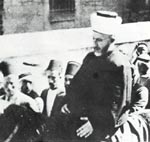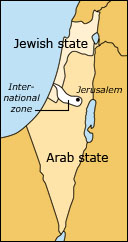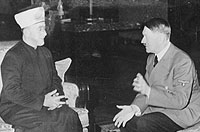|
Untitled Document
|
The
History
of Israel
- A Chronological Presentation

2.
The Establishment of Israel (1920 - 1939)
1920
- Arab Nationalism in Palestine
During and immediately after World War I
Arab nationalism awakened. Feisal Ibn-Hussein, a son
of the emir of Mecca, and the Zionist leader, Chaim
Weizmann, tried to work out a plan to realize the
national aspirations of both Jews and Arabs. But with
the loss of Damascus, the base of the Arab nationalists,
to France, cooperation with the Jews ended, and the
focus of Arab nationalism was instead directed towards
Jerusalem and Palestine.
1920-21 - The
first Arab Riots
Arab Nationalist leaders arranged demonstrations
against the Jewish National Home. In april 1920 rioters
attacked the Jewish population in Jerusalem. Many,
both Jews and Arabs were killed or wounded. In May
1921 Arab nationalists attacked Jews in the port city
of Jaffa, and soon the violence spread to other parts
of the country with several Jewish farming communities
coming under attack. After a week of fighting 47 Jews
were killed and almost 150 wounded. Many Arabs were
also killed and wounded, mostly in clashes with the
British troops that quelled the uprising. As a consequence
of the Arab violence the British administration tightened
the rules of Jewish immigration into Palestine.
1922
- The League of Nations and the Palestine Mandate
On July 24th, 1922 the agreement
on the mandates for Syria, Palestine and Mesopotamia
was confirmed by the League of Nations - the predecessor
of the United Nations. At the same time the League
of Nations approved the wording of the Balfour
Declaration. Thereby the international community
charged Britain with securing "the establishment
of a Jewish homeland" in Palestine.
 |
 |
| Transjordan
is severed from Palestine. |
1922 - Jordan Severed
from Palestine
In September 1922 Britain and the League
og Nations decided that the 3/4 of Palestine east
of the Jordan River would be excluded from the area,
in which the Jewish homeland was to be established.
The area was initially awarded limited autonomy under
the name of Transjordan, but was later granted full
independence as The Kingdom of Jordan. As leader of
this new state the British installed Abdullah, another
son of the Emir of Mecca.
1922-23 -
Failed Attemps at Arab-Jewish Power Sharing
Several attempts were made by the British High Commissioner
to Palestine at establishing various kinds of home-rule
for the mandate, in which both Jews and Arabs were to
participate. But the Palestinian Arabs rejected any
proposal that included power-sharing with the Jews.
1920's - Development
of the "Yishuv"
The Jewish community in Palestine (the "Yishuv")
developed rapidly in the 1920's. A Jewish parliament,
"Knesset Israel," was established, for which
also women could both run and vote. Responsibility
for Jewish religious, culturel and social affairs
was transferred to the Knesset. Later, in 1927, it
was also authorized to collect taxes from the Jewish
community, and became responsible for education, health
and social welfare within the Jewish sector. Unproductive
and arid land areas were cultivated, industrial businesses
were founded, and power plants and other infrastructure
were being built. Hebrew was used as a business language,
there was a Hebrew press, and in 1925 The Hebrew University
was inaugurated just outside Jerusalem.

Herzl
Street, Tel Aviv, 1920.
The Arabs also benefitted from the economic growth
of the Jewish sector. In 1925 the Jews made up only
about 15% of the population, while accounting for 45%
of the mandate's total tax revenues. Conversely, most
of the money was spent on the Arab sector, which, contrary
to the Jewish sector, didn't have any functioning welfare
system. All through the mandate period, in addition
to the massive Jewish immigration, there was a substantial
influx of Arabs from the surrounding countries.
 |
 |
Mufti
Haj Amin al-Husseini.
|
1929 - Renewed
Arab Attacks on Jews
The Muslim leader in Palestine, the Mufti of Jerusalem,
Haj Amin al-Husseini, initiated a campaign of false
rumors about Jewish threats against Muslim holy places,
followed by calls for attacks on Jews. Soon Jewish communities
all over Palestine were under attack. In some cities
Jews succeeded in defending themselves, but in other
areas regular massacres on Jews took place. In Hebron
67 Jews were murdered, and the rest of the Jewish inhabitants
driven out, ending two thousand years of uninterrupted
Jewish presence in the town.
1930-31 - Uncertainty about the Jewish National
Home
In reaction to the Arab violence of 1929
the British leadership in Palestine tightened the
rules for Jewish immigration and the sale of land
to Jews. But after protests from both the Zionist
Organization and the League of Nations, and an intense
debate about Britain's continued support for the Jewish
National Home, the provisions were annulled.
1933 - Jewish Immigration
Increasing
Hitler's rise to power in Germany in 1933 resulted in
renewed Jewish emigration from Europe, and Palestine
experienced the largest wave of Jewish immigration yet.
In the period of 1933-36 an estimated 175.000 Jews arrived,
bringing the Jewish population up to around 370.000.
The Arab population too, experienced massive growth
during the mandate period, since 1914 almost doubling
to 950.000.
1935 - Nazi
and Arab Anti-Jewish Propaganda
Arab scepticism towards Jewish immigration from Europe
was further exacerbated through German and Italian
anti-Jewish propaganda in the Arab World. Arab political
commentators disseminated myths of Zionist plans to
kill Arabs and desecrate mosques, and called for a
Palestinian "Jihad" against both Jews and
the British. In 1935 the powerful Arab Al-Husseini
clan founded the "Palestine Arab Party,"
along with an armed militia, "al-Futuwwa,"
for battle against the infidels.

British
forces engage Arab demonstrators, Jaffa 1936.
1936 - The Arab
Revolt
In April 1936, as a protest against the immigration
policy of the British mandate, the Mufti of Jerusalem,
Haj Amin al-Husseini, organized an general strike
and total Arab boycott of the mandate. Spontaneous
violence erupted, followed by organized attacks on
Jewish farming communities by Arab gangs. Civilian
Jews were murdered, livestock killed and crops destroyed.
The British accepted a Jewish demand for the arming
of 3000 Jewish guards ("ghaffirs"), which,
together with the Jewish underground organization,
Haganah, established in reaction to the Arab riots
of the 1920's, partly succeeded in defending Jewish
settlements against the Arab attacks. The revolt and
the accompanying strike was quite costly for the Arab
community, and by autumn the strike was called off,
and the violence died out.
 |
 |
| The
Peel Plan, 1937. |
1937 - The Peel Commission's
Partition Plan
A British commission of inquiry, led by Lord Robert
Peel, was sent to Palestine in order to find a solution
to the conflict. It suggested that the remaining part
of the mandate (after the detachment of Transjordan)
be partitioned into two states, one Jewish and one
Arab. The northwestern fifth of the area would constitute
a Jewish state, the remaining, much larger part, would
be Arab, while a strip from Jerusalem to the port
city of Jafffa would remain an international zone.
The plan included a "population swap" in
order to make the proposed states as ethnically homogeneous
as possible. Opinions on the issue were divided among
the Jews of Palestine, but the general sentiment pointed
towards hesitant acceptance. The Palestinian Arabs,
on the other hand, along with the rest of the Arab
World, rejected the plan, which was thus abandoned.
 |
 |
| Mufti
Haj Amin al-Husseini in conversa-
tion with Hitler. |
1937 - Arab-German
Alliance
Nazi Germany also rejected any partition
of Palestine, which could lead to "a Jewish position
of power," and intensified its efforts to strengthen
its position among the Arabs. In July 1937 the Mufti
of Jerusalem, Haj Amin al-Husseini, expressed his
personal admiration of the new Germany. The Arab press
in Palestine too, showed support for the European
Nazism and fascism, and copied energetically from
the European anti-Semitic propaganda. In exchange
the Nazis supplied weapons for the Palestinian Arabs'
fight against the Jews.
1937 - The
Arab Revolt Resumed
In the autumn of 1937 the Arab revolt was
resumed, and attacks on Jewish settlements and murders
of Jewish civilians reached a new high. In 1938 the
Haganah (Jewish underground militia) adopted a more
offensive strategy and organized mobile units, which
staged nightly attacks against Arab guerrilla bases,
inflicting heavy losses on the Mufti's rebels. Also
British soldiers were victims of Arab attacks, prompting
Britain to clamp down on the Arab leadership. Mufti
Haj Amin escaped to Lebanon, from where he continued
to direct the fighting - not only against Britain
and the Jews, but also against his Arab opponents
in Palestine. When the revolt was finally suppressed
in August 1939 the number of dead had reached 2.394
Jews, 610 British and 3.764 Arabs, including hundreds
of Arab victims of the Mufti's terror.
Continue:
Chapter 2 - The Establishment of Israel - Page 3
Back
|
Untitled Document
|